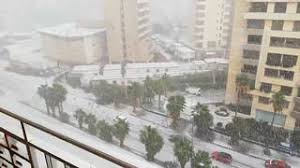Lebanon’s capital Beirut and the surrounding suburbs experienced what meteorologists named a “historical hailstorm,” which covered the capital in a white blanket for hours, causing massive floods and impeding traffic on the major coastal highway.

Al Arabiya English reached out to Elias Saadeh, founder of Lebanon Weather Forecast, who mentioned that Saturday’s phenomenon is due to severe supercell clouds. It lasted around an hour, coupled with severe thunderstorms and heavy hailstones.
“This supercell affected only the coastal area around Beirut and its suburbs. A supercell effect is always local. Weather stations in Beirut recorded 50mm of rainfall in a lapse of 25 minutes. This quantity is considered enormous since it is equivalent to pouring 50 liters of water in each square meter in 25 minutes. Moreover, this supercell caused a drastic drop in temperature from 21°C to 13.5°C in a couple of minutes,” added Saadeh.
Saadeh added that supercell was formed because of favorable environmental atmospheric conditions, including but not limited to the variation in temperature between the sea surface temperature and the temperature in the upper levels of the atmosphere.
“The updraft and downdraft flows became organized and twisted around and reinforced each other. The updraft speed might have reached around 30 meters per second, explaining the size of hailstones recorded,” he added.
Saadeh elaborated that historically, and according to available captures of the previous severe hailstorms, the last time Beirut witnessed a similar event was in the year 1968.
The heavy hailstorm in Beirut has prompted prayers and messages of support from residents to those whose homes still bear the devastating hallmarks of massive blast that battered the city in August.
As people took to social media on Saturday showing streets, cars and homes covered in a white icy sheet, many commented that their hearts go out to those who continue to live in homes ravaged by the explosion.
One Twitter user commented: “Think of all the people whose homes were damaged in the blast who can’t afford to repair them properly, now having to cope with icy cold.”
Snow in Beirut ?
— Liz Sly (@LizSly) December 5, 2020
Think of all the people whose homes were damaged in the blast who can’t afford to repair them properly, now having to cope with icy cold. https://t.co/6yw8UQ3ex7
Another wrote on the social media platform: “My joy at seeing this much hail in Beirut for the first time in ages lasted but a few minutes; and then I thought of all those who are still without doors, or even homes, during such weather.”
My joy at seeing this much hail in Beirut for the first time in ages lasted but a few minutes; and then I thought of all those who are still without doors, or even homes, during such weather.
— Talala (@Tala5La) December 5, 2020
May they be safe and warm and may those who deprived them the joys of winter suffer. pic.twitter.com/JSoiTONRiX
“May they be safe and warm and may those who deprived them the joys of winter suffer.”
A local resident write on Twitter that the scene felt “apocalyptic” and “like a disaster movie.”
The August 4 explosion of hundreds of tons of ammonium nitrate stored at Beirut port killed more than 190 people, wounded thousands and ravaged large parts of the capital.
The explosion left tens of thousands of apartments damaged and an estimated hundreds of thousands of residents temporarily displaced.
The United Nations Office for the Coordination of Humanitarian Affairs estimated at the time that some 47,000 apartments were damaged or destroyed in the blast.
AL ARABIYA
Leave a Reply
You must be logged in to post a comment.